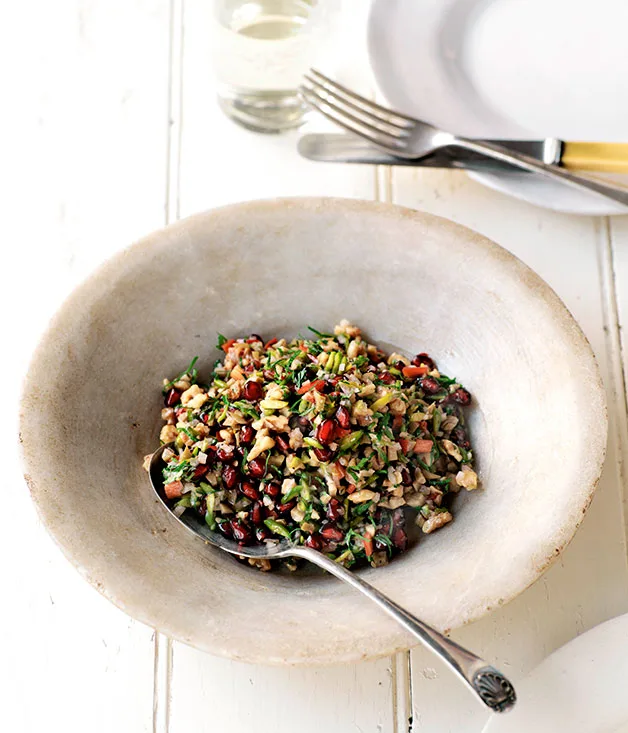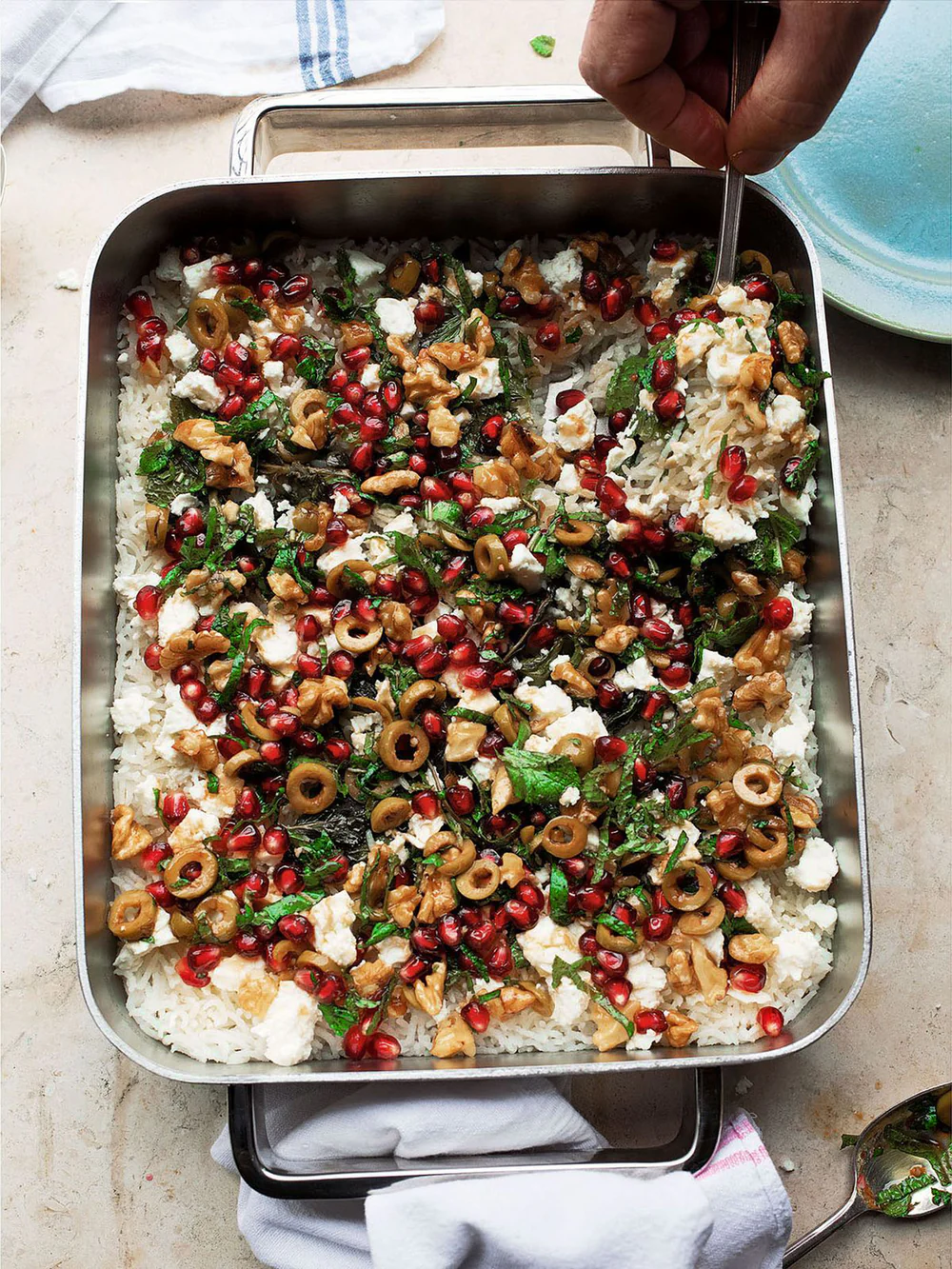A Turkish? salad - collected or created?
- rosemary
- Sep 22, 2024
- 6 min read
"a thrilling mix of flavours, textures and colours that is almost too glorious to look at." Claudia Roden

Geography is what has guided this post, which began from this lucky dip recipe from Claudia Roden's Med - Green olive, walnut and pomegranate salad. The link is to it's publication on the Food and Travel website. I confess I was somewhat uninspired, even though it looked like a lovely side-dish for a barbecue or some such. But what else to say? Well people, I have now travelled around some little-known corners of the Middle-East, taking in UNESCO, shepherds and - how one dish morphs into another - and why. Not to mention whether Claudia Roden is a collector or a creator.
At first I decided that in this instance she was a creator, even though her introduction to the recipe claims it is a speciality of Gaziantep - a Turkish city on the border with Syria, famous for its gastronomy - about which more in a moment.
So Claudia Roden - one of the early collectors of recipes from parts of the Mediterranean that to those of us who had grown up post WW2 were unknown - at least as far as food was concerned. Collecting recipes and allowing us to partake of her discoveries was one of my mid-life joys, and I'm guessing those of many others. Well she sold a lot of books. Med in fact is a worthwhile summary of her life's work.
However, when I first started my 'research' - because of just inserting her title for the recipe into Google, what I overwhelmingly got was other people publishing their version of her recipe and parroting her introductory words. Below a few - Cooks Without Borders; Shorrk; Food.com
So I began to wonder whether Claudia had made it up - albeit inspired by things she had tasted in her travels.

This idea was reinforced when I started to investigate Gaziantep - a town in Southern Turkey, I discovered, near the Syrian border.
"Gaziantep is situated on the Syrian border of Turkey between Mesopotamia and a point close to the Mediterranean end of the Silk Road. Its cuisine represents a diverse heritage, a fusion of Anatolian, Mediterranean, Middle Eastern and Ottoman, and is acknowledged as the richest in Turkey." Sheridan Rogers
It was reinforced because immediately I found lots of recipes for a salad called Gavurdagi which, although it contains those three basic ingredients also includes chopped tomatoes, and sometimes peppers as well. It's a rather runnier affair - as these versions below show - from Vidar Bergum; Ozlem's Table; Unicorns in the Kitchen and Musa Dagdeviren. I think there might be cucumber in there as well
Not really the same thing, because of the dominance of the tomatoes I suppose. Indeed one of those authors whose dishes are depicted above - Vidar Bergum said:
"the preparation can vary quite substantially. Some like it chunky. Others, like Ali Haydar Usta, so finely chopped the salad is virtually swimming in its own juices."
That claim by Sheridan Rogers - in her article on Gazientep cuisine led to the discovery that it is in fact a UNESCO Creative City for Gastronomy, and indeed there do seem to be a number of well-known - in culinary circles - dishes that emanate from there - e.g.: Yumurta piyazi (Egg salad); Katmer - a pistachio filled filo pastry; a black-eyed pea salad, and Yuvarlama - a yoghurt soup - but there are many more.

Then came another sort of red herring - Olive and walnut salad (Shepherd's dinner) from a website called The Armenian Kitchen which claimed this olive and walnut salad - and yes there was pomegranate too - from a place called Musa Ler in Armenia. Armenia? I confess my geography of that belt - I suppose the Silk Road - countries which stretches across Asia is vague to say the least, so at first I thought, oh well, maybe Armenia borders that part of Turkey where Gazientep is. So I looked it up - and no it isn't. It's actually quite a distance away. So I looked up Shepherd's dinner and it is indeed an Armenian dish which makes use of the walnuts and olives that grow there in great abundance. The recipe I found is almost identical to the one from Turkey, although there is a little tomato paste and parsley in there as well. But that's the sort of thing that anyone might add isn't it?
And my geography lesson didn't end there, because then up popped Zeytoon Parvardeh-Persian Olive, Pomegranate and Walnut Salad. Iran? Back to Google Maps because I thought this also might be next to Armenia. But again no - well not the part of Iran - Gilan Province that this dish comes from. So we have Gaziantep - in the far south of Turkey almost on the Mediterranean, Armenia - near Northern Turkey and almost on the Caspian Sea and Gazientep - on the Caspian Sea and south of Armenia. But then maybe those are all stops on the Silk Road which would explain the connection, (yes I think they are) as would the geography that meant that the same crops were grown in each of those areas.
The dish in question this time, is rather more of a marinated olives dish than an actual salad, and the walnuts are grated or sliced thin, not as visible as in the salads. But fundamentally the same taste idea I guess. The three below are Zeytoon Parvardeh-Persian Olive, Pomegranate and Walnut Salad from Turmeric and Saffron, Green olive, pomegranate and olive salad - Greg Malouf/Gourmet Traveller and Yasmin Khan's version, which sadly is not online. And Greg Malouf recognised the connection saying in his introduction to the recipe in his book Saraban:
"Interestingly this sweet-sour-salty combination is also popular in the neighbouring southern provnces of Turkey."

Just to end it all, whilst I was revisiting Claudia Roden I found that Paula Woolfert in America in her book Cooking of the Eastern Mediterranean had also made the same salad which was published in The New York Times as Zetyin Piyazi - so finally a name - a Turkish one, which, however The New York Times labelled as a relish and which looks rather more like the Persian dish.
All of which goes to show how trade routes and geography influence food. And also, yes, Claudia Roden is fundamentally a collector, a recorder and a sharer. Passing her discoveries on via the modern trade routes of book publishing, TV and the internet.
And so some modern European cooks have used that basic mix of ingredients in slightly different ways. I have not searched exhaustively here, but here are three: Green olive, walnut and pomegranate potato salad - Taste; Olive salad with lemon-pomegranate dressing - The Mediterranean Dish whose author said: "I wanted to give this olive salad a very strong Mediterranean flavor, so I used many go-to ingredients from my Mediterranean pantry". It's similar to the Turkish original, but just slightly different - and yes - Ottolenghi - with his Baked mint rice with pomegranate and olive salsa.
I can see that you might add those three ingredients to a chicken dish perhaps, or maybe fish. A pesto/tapenade? ...
Med is a lovely book. Locally Readings have it a special low price I think. It's a sort of 'Best of' Claudia Roden book if you don't have any of her works.
POSTSCRIPT

Last night's dinner of Marmalade chicken - David said I should post a photo, but I apologise for it. I am neither a proficient food stylist, nor a proficient food photographer. Anyway here it is and it was indeed very tasty. Difficult to keep the marmalade mustard dressing on the chicken pieces, but yes - would recommend. David gave it 4 stars - me a bit less I think. Perhaps I'm getting old and jaded.
Those years gone by - September 22
2023 - Lush - Welsh food
2022 - Normality - a Coles shop
2021 - Nothing
2020 - Outdone by the grandchildren
2019 - Red cabbage
2018 - Cooking with beer
2017 - "Eating breakfast of warm flatbread and honey in the open air" A lucky dip - this is rather sad because I think that breakfast was in Aleppo - before the Syrian war.



































Must disagree with you abou the presentation of your delicious 4 star marmalade flavoiured chicken dish, which we had last night. Definitely the best dish and layout on today's blog, which was very colourful, but not as appetising. But then it is all in an individual's sense of what is best!